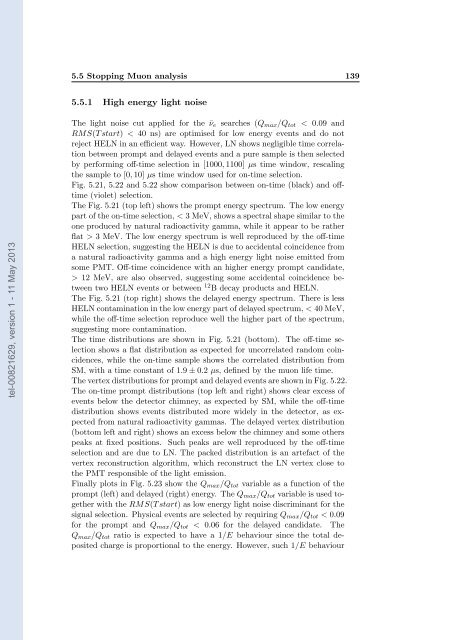Etude et impact du bruit de fond corrélé pour la mesure de l'angle ...
Etude et impact du bruit de fond corrélé pour la mesure de l'angle ...
Etude et impact du bruit de fond corrélé pour la mesure de l'angle ...
Create successful ePaper yourself
Turn your PDF publications into a flip-book with our unique Google optimized e-Paper software.
5.5 Stopping Muon analysis 139<br />
5.5.1 High energy light noise<br />
tel-00821629, version 1 - 11 May 2013<br />
The light noise cut applied for the ¯⌫ e searches (Q max /Q tot < 0.09 and<br />
RMS(Tstart) < 40 ns) are optimised for low energy events and do not<br />
reject HELN in an e cient way. However, LN shows negligible time corre<strong>la</strong>tion<br />
b<strong>et</strong>ween prompt and <strong>de</strong><strong>la</strong>yed events and a pure sample is then selected<br />
by performing o↵-time selection in [1000, 1100] µs time window, rescaling<br />
the sample to [0, 10] µs time window used for on-time selection.<br />
Fig. 5.21, 5.22 and 5.22 show comparison b<strong>et</strong>ween on-time (b<strong>la</strong>ck) and o↵time<br />
(viol<strong>et</strong>) selection.<br />
The Fig. 5.21 (top left) shows the prompt energy spectrum. The low energy<br />
part of the on-time selection, < 3 MeV, shows a spectral shape simi<strong>la</strong>r to the<br />
one pro<strong>du</strong>ced by natural radioactivity gamma, while it appear to be rather<br />
f<strong>la</strong>t > 3 MeV. The low energy spectrum is well repro<strong>du</strong>ced by the o↵-time<br />
HELN selection, suggesting the HELN is <strong>du</strong>e to acci<strong>de</strong>ntal coinci<strong>de</strong>nce from<br />
a natural radioactivity gamma and a high energy light noise emitted from<br />
some PMT. O↵-time coinci<strong>de</strong>nce with an higher energy prompt candidate,<br />
> 12 MeV, are also observed, suggesting some acci<strong>de</strong>ntal coinci<strong>de</strong>nce b<strong>et</strong>ween<br />
two HELN events or b<strong>et</strong>ween 12 B <strong>de</strong>cay pro<strong>du</strong>cts and HELN.<br />
The Fig. 5.21 (top right) shows the <strong>de</strong><strong>la</strong>yed energy spectrum. There is less<br />
HELN contamination in the low energy part of <strong>de</strong><strong>la</strong>yed spectrum, < 40 MeV,<br />
while the o↵-time selection repro<strong>du</strong>ce well the higher part of the spectrum,<br />
suggesting more contamination.<br />
The time distributions are shown in Fig. 5.21 (bottom). The o↵-time selection<br />
shows a f<strong>la</strong>t distribution as expected for uncorre<strong>la</strong>ted random coinci<strong>de</strong>nces,<br />
while the on-time sample shows the corre<strong>la</strong>ted distribution from<br />
SM, with a time constant of 1.9 ± 0.2 µs, <strong>de</strong>fined by the muon life time.<br />
The vertex distributions for prompt and <strong>de</strong><strong>la</strong>yed events are shown in Fig. 5.22.<br />
The on-time prompt distributions (top left and right) shows clear excess of<br />
events below the d<strong>et</strong>ector chimney, as expected by SM, while the o↵-time<br />
distribution shows events distributed more wi<strong>de</strong>ly in the d<strong>et</strong>ector, as expected<br />
from natural radioactivity gammas. The <strong>de</strong><strong>la</strong>yed vertex distribution<br />
(bottom left and right) shows an excess below the chimney and some others<br />
peaks at fixed positions. Such peaks are well repro<strong>du</strong>ced by the o↵-time<br />
selection and are <strong>du</strong>e to LN. The packed distribution is an artefact of the<br />
vertex reconstruction algorithm, which reconstruct the LN vertex close to<br />
the PMT responsible of the light emission.<br />
Finally plots in Fig. 5.23 show the Q max /Q tot variable as a function of the<br />
prompt (left) and <strong>de</strong><strong>la</strong>yed (right) energy. The Q max /Q tot variable is used tog<strong>et</strong>her<br />
with the RMS(Tstart) as low energy light noise discriminant for the<br />
signal selection. Physical events are selected by requiring Q max /Q tot < 0.09<br />
for the prompt and Q max /Q tot < 0.06 for the <strong>de</strong><strong>la</strong>yed candidate. The<br />
Q max /Q tot ratio is expected to have a 1/E behaviour since the total <strong>de</strong>posited<br />
charge is proportional to the energy. However, such 1/E behaviour





![[tel-00726959, v1] Caractériser le milieu interstellaire ... - HAL - INRIA](https://img.yumpu.com/50564350/1/184x260/tel-00726959-v1-caractacriser-le-milieu-interstellaire-hal-inria.jpg?quality=85)










